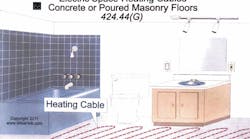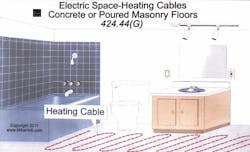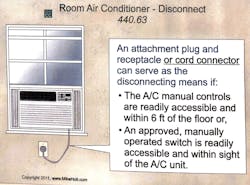Thank you for visiting one of our most popular classic articles. If you’d like to see updated information on this topic, please check out this recently published article, Understanding Requirements for Appliances. |
Note: This article is based on the 2011 NEC.
Article 422 covers electric appliances used in any occupancy. Most NEC articles include definitions unique to that article in a dedicated subsection with the “.2” ending. Until the 2011 revision, Art. 422 didn’t have such a section and provided the definition for “vending machine” in 422.51. That definition is now in the new Sec. 422.2.
With the 2011 revision, each appliance must have a means to simultaneously disconnect all ungrounded circuit conductors [422.30]. The NEC has long required appliances to have a means to disconnect the ungrounded conductors supplying them, just not simultaneously. This change helps coordinate this requirement with the provisions of 240.15.
That’s not the only disconnect-related change in Art. 422. How you apply the requirements of 422.31 depends on the VA rating and horsepower rating of the appliance. The horsepower rating is actually for the motor of the appliance, yet it raises a concern.
Article 430 requires motors to have a lockable disconnect within sight. What if a lockable disconnect isn’t within sight of a motor-driven appliance? That used to be a confusing aspect of Art. 422. The 2011 NEC clarifies that the branch circuit overcurrent device can serve as the disconnect for appliances (if they are not over 300VA or 1/8 hp) [422.31(A)].
Another source of confusion has been in applying the requirements of 422.32, which pertained only to motor-driven appliances and differed from those in 422.31. In the 2011 Code, 422.32 is gone. A new subsection 422.31(C) exists for appliances rated over 1⁄8 hp (motor driven) and 422.31(B) now addresses appliances rated over 300VA.
In the 2011 NEC, revision of 422.31 addresses the disconnection of permanently connected appliances in the following subsections:
- Subsection (A) applies to nonmotor-operated appliances not over 300VA and motor-operated appliances less than 1⁄8 hp.
- Subsection (B) applies to nonmotor-operated appliances of greater than 300VA.
- Subsection (C) applies to motor-operated appliances greater than 1⁄8 hp.
- The exception formerly found in 422.32 now applies to 422.31(C).
Fixed Space Heaters
Has the sheer number of pages in Art. 424 ever struck you as a bit “over the top?” This is a nine-part article on fixed electric space heaters. Why so much text for what seems to be a simple application? The answer is that heaters come in many configurations for various uses, and Art. 424 covers them all. Not all of this article applies to electricians in the field though, because Part IV is for manufacturers.
Fixed space heaters (wall-mounted, ceiling-mounted, or free-standing) are common in utility buildings and other small structures as well as in some larger structures. When used to heat floors, space-heating cables help solve the thermal layering problem typical of forced-air systems — so they are in widespread use. Duct heaters commonly provide a distributed heating scheme in large office and educational buildings. Locating the heater in the ductwork close to the occupied space eliminates the waste of transporting heated air through sheet metal ductwork routed in unheated spaces.
The motors for fixed electric space-heaters are now considered a continuous load [424.3(B)]. Thus, size the branch circuit at 125%.
GFCI
Motors
Article 430 (see Article 430 Issues on page 37) didn’t change very much in the 2011 NEC. However, there was a change in the requirements for cord- and plug-connected motors. While portable motors typically plug into receptacles, often they’re connected to the cord connector of a pendant cord or a flanged surface inlet. Though 210.50(A) addresses cord connectors attached to a pendant cord, 430.109(F) now addresses these as well.
For a motor disconnecting means, you can use any of the following if they have a horsepower rating not less than the motor rating:
- Horsepower-rated attachment plug and receptacle.
- Flanged surface inlet and cord connector.
- Attachment plug and cord connector.
Air-conditioning and Refrigeration Equipment
Article 440 includes some changes for air conditioners, beginning with cord-connected room air conditioners. It’s similar to the change we just looked at in Art. 430. While cord- and plug-connected room air conditioners typically plug into receptacles, often they’re connected to the cord connector of a pendant cord. While 210.50(A) addresses this type of installation, 440.63 has now been revised to include such situations.
- The manual controls on the room air conditioner are readily accessible and within 6 ft of the floor, or
- A readily accessible disconnecting means is within sight from the room air conditioner.
Generators
Generators are basically motors that operate in reverse — they produce electricity when rotated instead of rotating when supplied with electricity. Article 430, which covers motors, is the longest article in the NEC. Article 445, which covers generators, is one of the shortest. At first, this might not seem to make sense, but you don’t need to size and protect conductors to a generator. You do need to size and protect them to a motor.
Generators need overload protection, and it’s necessary to size the conductors that come from the generator. However, these considerations are more straightforward than the equivalent considerations for motors.
The Scope section for Art. 445 has been revised to be more accurate. Previously, it said, “This article covers the installation of generators.” Now it says, “This article contains installation and other requirements for generators.” [445.1]
While Art. 445 does cover the installation of generators, it also covers the location, marking, overcurrent protection, internal bushing requirements, terminal housings, and disconnecting means for generators. In addition, it covers the ampacity of conductors from the generator terminal to the first disconnecting means with overcurrent protection. Instead of including this long list of items, the Code-Making Panel decided to shorten it by stating that Art. 445 covers “installation and other requirements” for generators.
Generators, associated wiring, and equipment must be installed in accordance with the following requirements, depending on their use:
- Article 695, Fire Pumps
- Article 700, Emergency Systems
- Article 701, Legally Required Standby Systems
- Article 702, Optional Standby Systems
Transformers
Article 450 opens by saying, “This article covers the installation of all transformers.” Then it lists eight exceptions. So what does Art. 450 really cover? Essentially, it covers power transformers and most kinds of lighting transformers.
The prevention of overheating is a major concern with transformers. The NEC doesn’t completely address this issue, because the NEC isn’t a design manual [90.1(C)].
Proper transformer selection, which the NEC doesn’t address, is an important part of preventing transformer overheating. You need to select a transformer suitable for the load characteristics, the application, and the environment.
Once you’ve done that, Art. 450 takes you through the next logical steps — providing overcurrent protection, making the proper connections, meeting ventilation requirements, and allowing for accessibility.
- Part I contains the general requirements such as guarding, marking, and accessibility.
- Part II contains the specific provisions for different types of transformers.
- Part III covers transformer vaults.
Article 450 doesn’t go into acceptance testing or maintenance. For those, you’ll need to refer to other standards.
Disconnecting Means
A new section, 450.14, requires a disconnecting means for most transformers. In previous NEC editions, transformers didn’t require a disconnecting means. Although there were no documented injuries to warrant this change, it’s obvious that this requirement should enhance safety.
Disconnecting
We just ran through an overview of changes to eight NEC articles. We were able to do that in so little space because the changes weren’t extensive. Did you notice a recurring theme here? The 2011 NEC requires disconnects where previously they weren’t required.
Adding more disconnects will slightly increase construction costs if they were not already included by designers. In addition to the safety benefits, reduced maintenance costs will also provide savings to offset the increased construction costs. This is why engineering best practices required disconnects even where the NEC previously did not.
For more information on this topic, read "Understanding Requirements for Appliances."
SIDEBAR: Article 430 Issues
Because Art. 430 is so large, Code users sometimes feel overwhelmed by it. The solution to that problem is to proceed methodically through your motor system installation using Fig. 430.1 in the NEC. This illustration gives a good graphical representation of which Parts of Art. 430 apply to which parts of the motor system.
A second issue involves sizing the motor branch circuit overcurrent protection. Remember, an overload isn’t the same thing as a short circuit or ground fault. The fuse or circuit breaker protects the motor branch circuit against short circuits or ground faults, but it is sized large enough to allow the motor to draw the additional current needed for startup [430.52]. By sizing the branch circuit short circuit and ground fault protection device this large, it will not provide overload protection for the motor. That’s why separate motor overload protection is required [430.32(A)(1)]. This makes overcurrent protection for motor applications necessarily different from the protection employed for other types of equipment. So don’t confuse general overcurrent protection with motor protection — you must calculate and apply them differently using the rules in Art. 430.






